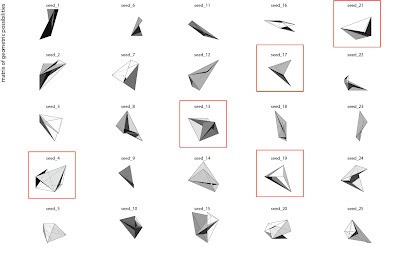Reverse-Morphometric Process
(Unfolding Complex Geometries)
This exercise involved a serial exploration of the base geometry used in the Recursive Folding process (see previous entry). Rather than utilizing a lo-res base geometry to build spatial complexity, this exploration used a lo-res base geometry and worked backwards to strategically unfold the complex spatial-form into a developable plane. The purpose of the new trajectory is to understand how a project state can be assumed and then used to reverse engineer the process into a more tangible starting point. These simplified forms also contain the a greater potiental to be aggregated into a single larger structure that would be defined by its enclosure (as opposed to its mass).The first step involved generating (25) 5-sided triangulated shapes. The surfaces all share corner points and edges with adjacent surfaces. These 25 possibilities were analyzed to determine if any planes intersected one another (which many did). Five forms were chosen to be studied through the reverse-morphometric process.click image for larger view The chosen forms each went through a 4 step iterative process. At each step there were several options for the form: rotation of a surface about an adjacent edge, re-triangulation of a surface based on corner points of other surfaces, and deletion of non-confoming surfaces.click image for larger view
The chosen forms each went through a 4 step iterative process. At each step there were several options for the form: rotation of a surface about an adjacent edge, re-triangulation of a surface based on corner points of other surfaces, and deletion of non-confoming surfaces.click image for larger view


No comments:
Post a Comment